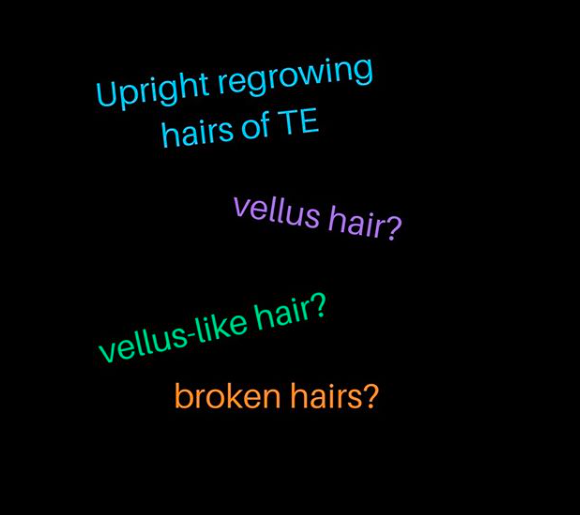Baby Hairs: Good or Bad?
The Three Categories of Baby Hairs
There are many type of hairs that constitute “baby hairs.” Some of these are positive signs (good signs) as they indicate that this hair has a high chance of growing longer and contributing in a few months to the overall density that a patient feels. The call these group 1 baby hairs. The upright regrowing hairs of telogen effluvium are one such example and so are the normal regrowing scalp hairs that everyone has (new anagen hair). The regrowth that is seen about 2-3 months after starting a new treatment is also an example of Group 1 baby hairs.
Some baby hairs including the vellus-like hairs of androgenetic alopecia, the sick dying vellus-like hairs of scarring alopecias and the vellus hairs of alopecia areata do not mean that baby hairs will turn into something substantial. I call these group 2 baby hairs.
Some baby hairs that people see can also be broken hairs. These are far less common. I call these Group 3 baby hairs. Hair breakage from excessive heat or hair breakage from trichotillomania are all examples of phenomena that can give broken hairs and in turn give the appearance of baby hairs. The exclamation mark hairs of alopecia areata are also an example. Broken hairs are important to identify but these types of hairs are often misdiagnosed. In fact, most people who think they have broken hairs are wrong. They don’t, of course, usually think they are wrong, but they are often wrong about that too. Most people with baby hairs have Group 1 of Group 2 baby hairs. Group 3 hairs are blunt at the top like a freshly cut blade of grass cut by a lawnmower. Group 1 and 2 hairs are pointy with tapered ends pointing up to the sky.
It’s always better to see one hair growing than to see none. So when a patient says “I’m seeing baby hairs but I’m not sure my hair is getting better” my concerns is that this patient may in fact have one of the hair loss conditions giving the so called Group 2 or Group 3 conditions.
This article was written by Dr. Jeff Donovan, a Canadian and US board certified dermatologist specializing exclusively in hair loss.

